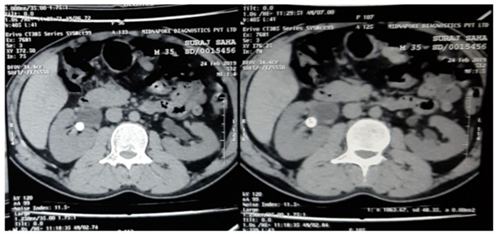An observational study on the predictability of the Triple-D score in the success rate of extracorporeal shock wave lithotripsy in renal stones 1 – 2 cm in diameter
Triple D score predicts SFR after ESWL successfully
Abstract
Introduction: Evaluation of Triple-D scoring system to assess the stone free rate in individuals who were given extracorporeal shock wave lithotripsy (ESWL) for renal stones measuring 10-20 mm in diameter. Materials and methods: The study subjects were 120 patients who presented to the urological outpatient department with complaints of renal stones. Systemic Random Sampling technique was applied to select study subjects for study population with a Sampling Interval of 2. Prior to ESWL, Triple-D scoring comprising of three CT based metrics - stone dimension (volume), stone density (HU) and skin-to-stone distance (SSD) was done prior to ESWL as described by Tran et al. The score ranged from 0 (worst) to 3 (best). Treatment efficacy was studied by plain abdominal radiography three weeks after ESWL. Complete clearance was considered the “stone free status”. Results: In the study population, stone dimension, stone density and stone location were positive predictors of stone free rate after ESWL whereas age, sex and BMI of the patients, laterality of the stone and skin to stone distance were not. The area under the curve (AUC) of Triple-D scoring system was 0.598.Conclusion: Triple-D scoring system has been successfully validated as the SFR showed a parallel increase with every positive component.
Downloads
References
Turk C, Petrik A, Sarica K et al (2016) EAU guidelines on interventional treatment for urolithiasis. EurUrol 69(3):475–482
Assimos D, Krambeck A, Miller NL et al (2016) Surgical management of stones: American Urological Association/Endourological Society guideline, PART II. J Urol 196(4):1161–1169
Kanao K, Nakashima J, Nakagawa K et al (2006) Preoperative nomograms for predicting stone-free rate after extracorporeal shock wave lithotripsy. J Urol 176(4 Pt 1):1453–1456
Leavitt D, de la Rosette J, Hoenig D (2016) Strategies for nonmedical management of upper urinary tract calculi. In: Wein A, Kavoussi L, Partin A, Peters C (eds) Campbell-Walsh’s urology. Elsevier, Philadelphia, pp 1235–1259
Dretler SP (1988) Stone fragility—a new therapeutic distinction. J Urol 139(5):1124–1127
Ringdén I, Tiselius HG (2007) Composition and clinically determined hardness of urinary tract stones. Scand J UrolNephrol 41(4):316–323
Pareek G, Armenakas NA, Fracchia JA (2003) Hounsfield units on computerized tomography predict stone-free rates after extracorporeal shock wave lithotripsy. J Urol 169(5):1679–1681
Pareek G, Hedican SP, Lee FT Jr, Nakada SY (2005) Shock wave lithotripsy success determined by skin-to-stone distance on computed tomography. Urology 66(5):941–944
Ng CF, Siu DY, Wong A, Goggins W, Chan ES, Wong KT (2009) Development of a scoring system from noncontrast computerized tomography measurements to improve the selection of upper ureteral stone for extracorporeal shock wave lithotripsy. J Urol 181(3):1151–1157
Pareek G, Armenakas NA, Panagopoulos G, Bruno JJ, Fracchia JA (2005) Extracorporeal shock wave lithotripsy success based on body mass index and Hounsfield units. Urology 65(1):33–36
Tran TY, McGillen K, Cone EB, Pareek G (2015) Triple D Score is a reportable predictor of shockwave lithotripsy stone-free rates. J Endourol 29(2):226–230
Gokce MI, Esen B, Gulpinar B, Suer E, Gulpinar O (2016) External validation of Triple D Score in an elderly (>/=65 years) population for prediction of success following shockwave lithotripsy. J Endourol 30(9):1009–1016
Ozgor F, Tosun M, Kayali Y, Savun M, Binbay M, Tepeler A (2017) External validation and evaluation of reliability and validity of the Triple D Score to predict stone-free status after extracorporeal shockwave lithotripsy. J Endourol 31(2):169–173
Ichiyanagi O, Fukuhara H, Kurokawa M, et al. Reinforcement of the Triple D score with simple addition of the intrarenal location for the prediction of the stone-free rate after shockwave lithotripsy for renal stones 10-20 mm in diameter. IntUrolNephrol. 2019;51(2):239-245.
Wiesenthal JD, Ghiculete D, Ray AA, Honey RJ, Pace KT (2011) A clinical nomogram to predict the successful shock wave lithotripsy of renal and ureteral calculi. J Urol 186(2):556–562
El-Nahas AR, El-Assmy AM, Mansour O, Sheir KZ (2007) A prospective multivariate analysis of factors predicting stone disintegration by extracorporeal shock wave lithotripsy: the value of high-resolution noncontrast computed tomography. EurUrol 51(6):1688–1693
Perks AE, Schuler TD, Lee J et al (2008) Stone attenuation and skin-to-stone distance on computed tomography predicts for stone fragmentation by shock wave lithotripsy. Urology 72(4):765–769
Abdel-Khalek M, Sheir KZ, Mokhtar AA, Eraky I, Kenawy M, Bazeed M (2004) Prediction of success rate after extracorporeal shock-wave lithotripsy of renal stones—a multivariate analysis model. Scand J UrolNephrol 38(2):161–167
Ichiyanagi O, Nagaoka A, Izumi T, Kawamura Y, Kato T (2015) Age-related delay in urinary stone clearance in elderly patients with solitary proximal ureteral calculi treated by extracorporeal shock wave lithotripsy. Urolithiasis 43(5):419–426
Halachmi S, Meretyk S (2006) Shock wave lithotripsy for ureteral stones in elderly male patients. Aging Male 9(3):171–174
Abdel-Khalek M, Sheir K, Elsobky E, Showkey S, Kenawy M (2003) Prognostic factors for extracorporeal shock-wave lithotripsy of ureteric stones—a multivariate analysis study. Scand J UrolNephrol 37(5):413–418
Ikegaya H, Kato A, Kumano S, Tominaga T (2005) Correlation between age and the efficacy of ESWL. BJU Int 96(7):1145
Vakalopoulos I (2009) Development of a mathematical model to predict extracorporeal shockwave lithotripsy outcome. J Endourol 23(6):891–897
Kim JK, Ha SB, Jeon CH et al (2016) Clinical nomograms to predict stone-free rates after shock-wave lithotripsy: development and internal-validation. PLoS ONE 11(2):e0149333



























